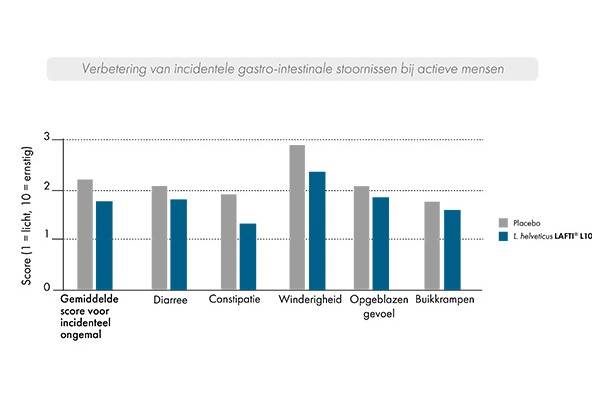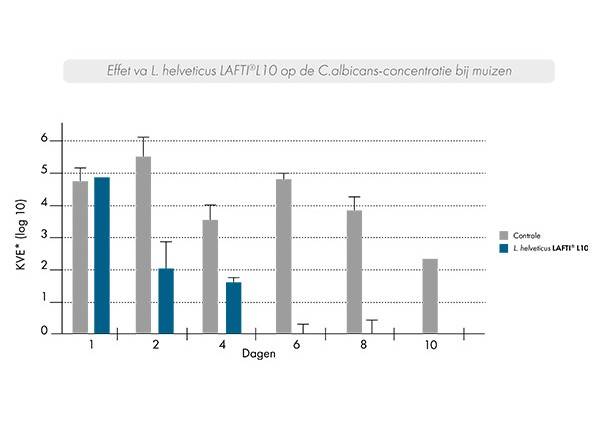
LACTOBACILLUS HELVETICUS LAFTI® L10 : EEN MICROBIOTASTAM MET BEWEZEN WERKZAAMHEID OP HET DARMCOMFORT EN TEGEN CANDIDIASIS
Lactobacillus helveticus, een geïsoleerde Gram+ staafvormige bacterie, is een melkzuurbacterie die op grote schaal wordt gebruikt bij de vervaardiging van gefermenteerde zuivelproducten. Het is met name aanwezig in Zwitserse Emmentaler kaas, vandaar de Latijnse naam « helveticus ». Sommige stammen van L. helveticus worden niet alleen gebruikt bij de bereiding van bepaalde kazen, maar hebben ook gunstige eigenschappen voor de darmgezondheid1 en in gevallen van candidiasis 2.
De geregistreerde stam van L. helveticus LAFTI® L10 is resistent tegen maagzuur en gal 3, en wordt gekenmerkt door een sterke hechting aan het darmepitheel 4, waardoor het de stam bij uitstek is voor de verbetering van het darmcomfort en de bestrijding van candidiasis.
in vivo gastro-intestinale modellen hebben het vermogen van L. helveticus LAFTI® L10 aangetoond om :
- de natuurlijke afweer te ondersteunen door te concurreren met ziekteverwekkers zoals, Listeria monocytogenes, E. coli en Candida albicans 5.
- in synergie met prebiotische vezels: FOS en inuline6 te werken
- de pro-inflammatoire respons te moduleren: daling van de colon myeloperoxidase (MPO) activiteit, daling van de productie van de ontstekingsmediator LTB4, stijging van het glutathiongehalte en ondersteuning van het antioxidantmetabolisme 3.
In een klinische studie bij 60 volwassenen verminderde, L. helveticus LAFTI® L10 aanzienlijk de occasionele gastro-intestinale onrust 7.

Bovendien heeft een mechanistische studie aangetoond dat L. helveticus LAFTI® L10 kolonisatie door C. albicans, de belangrijkste ziekteverwekker van vaginale bacteriose, verhindert 2.


*KVE : Kolonievormende eenheden
(1) Taverniti V., Guglielmetti S. (2012) Health-Promoting Properties of Lactobacillus helveticus. Frontiers in Microbiology. (3):392
(2) Elahi, S., G. Pang, R. Ashman, et R. Clancy. « Enhanced Clearance of Candida Albicans from the Oral Cavities of Mice Following Oral Administration of Lactobacillus Acidophilus ». Clinical & Experimental Immunology 141, no 1 (2005): 29 36. https://doi.org/10.1111/j.1365-2249.2005.02811.x.
(3) Welin A. et al.(2005).“Survival of L. acidophilus and L. casei in the human GI tract perceived effects on health” Nutrafoods (4): 2-3.Pang, G. (2005). A comparative study of probiotic bacterial strains in vitro and in vivo.
(4) Lallemand internal report
(5) Mahoney, M. and A. Henriksson (2003). “The effect of processed meat and meat starter cultures on gastrointestinal colonization and virulence of Listeria monocytogenes in mice.” Int J Food Microbiol 84(3): 255-261.
(6) Su, P., et al. (2007).”Selected prebiotics support the growth of probiotic monoculturesin vitro.” Anaerobe 13(3-4): 134-139 Peran, L., et al. (2007). “A comparative study of the preventative effects exerted by three probiotics, Bifdobacterium lactis, a.Lactobacillus casei and Lactobacillus acidophilus, in the TNBS model of rat colitis.” J Appl Microbiol 103(4): 836-844
(7) Paturi, G., et al. (2007). “Immune enhancing effects of Lactobacillus acidophilus LAFTI® L10 and Lactobacillus paracasei LAFTI® L26 in mice.” Int J Food Microbiol 115(1): 115-118











parfois un peu difficile de sélectionner/trouver les produits recvoir plus
Avis du 07/04/2025, suite à une expérience du 14/03/2025 par ANNICK D